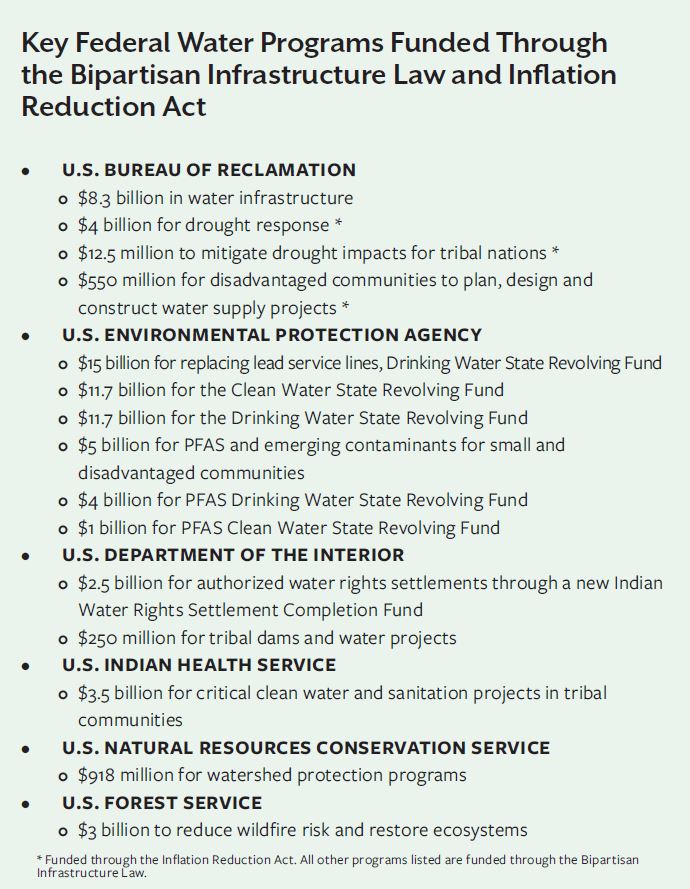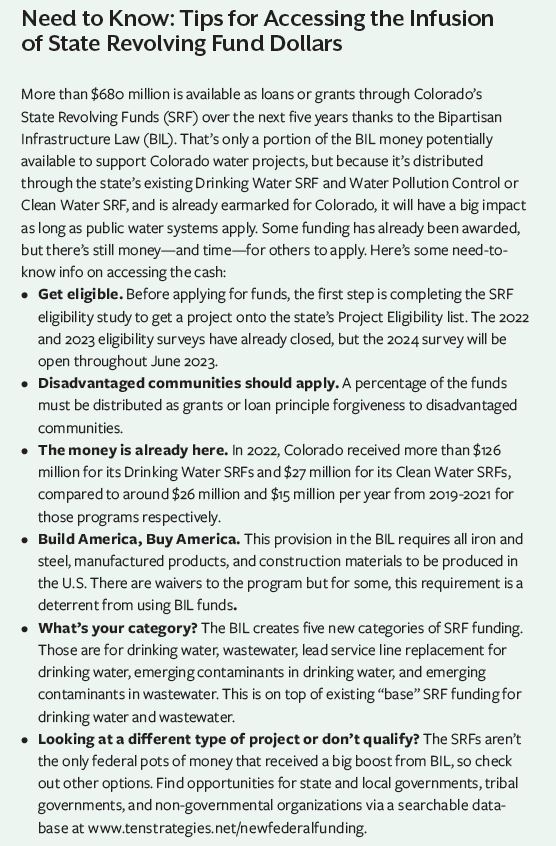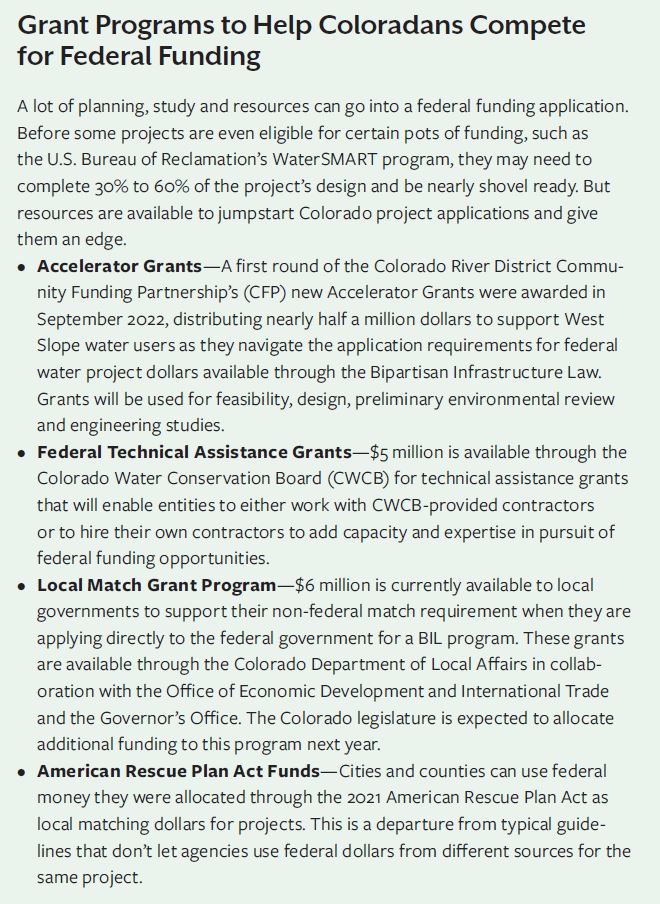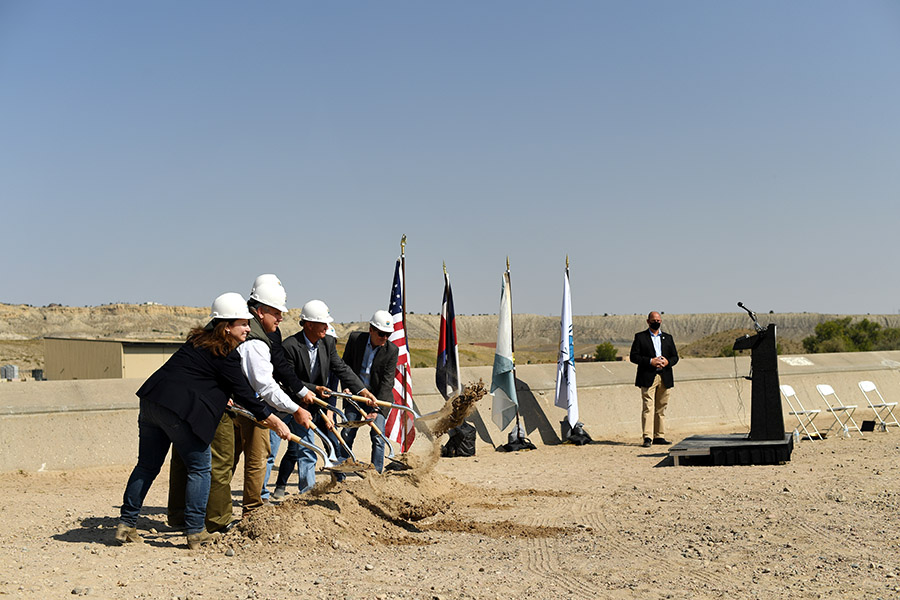The Bipartisan Infrastructure Law will make historic investments in Colorado water but getting the money to communities won’t come easy
Since 1962, people in Colorado’s Lower Arkansas Valley have heard talks of a pipeline that would bring them clean drinking water from Pueblo Reservoir upstream.
The 103-mile Arkansas Valley Conduit promises to be a long-term source of clean water for the region, where many people rely on poor-tasting and contaminated well water. The project was planned as part of the Fryingpan-Arkansas Project, but for decades, the pipeline was too expensive for the small towns to afford, $600 million by today’s estimates.
The project picked up momentum in 2009, when Congress amended legislation so that the federal government would contribute almost two-thirds of the project’s cost. Construction finally began a decade later, after another boost in federal funds. If the project stays on schedule, the pipeline will reach its easternmost destination, the town of Lamar, Colorado, in 2035.
Now, with $60 million in new funding from the Bipartisan Infrastructure Law, officials are hoping to cut the project’s remaining 13-year timeline in half — and ensure steady access to clean water for more than 50,000 people living east of Pueblo along the Arkansas River.
“People have waited 60 years to build this,” says Chris Woodka, a spokesperson for the Southeastern Colorado Water Conservancy District. “The Bipartisan Infrastructure Law has made it entirely feasible that we could do this in a much shorter time.”
Also known as the Infrastructure, Investment and Jobs Act, the law, enacted in 2021, authorizes more than $550 billion in new investment that will be spread across the nation, including more than $50 billion for clean water programs and another $8.5 billion for Western water needs. The historic federal investment comes as Colorado and other Western states face growing pressures from climate change, drought and a regional crisis along the Colorado River.
The funding won’t resolve the drought. But the law is an opportunity to fund critical repairs on neglected water systems, many which were built at the turn of the century.
Amy Moyer, director of strategic partnerships at the Colorado River District, hopes it will inspire water managers and public servants, who are used to engineering workarounds and funding projects piecemeal, to be more ambitious.
“It’s really giving [people] the license to think big,” Moyer says. The river district is giving grants to entities in its 15-county area to conduct studies and develop competitive applications for the federal money. “Projects that were previously unachievable because of a huge financial cost might be back on the table.”
Colorado could receive between $800 million and $1.2 billion for water projects alone, according to an early estimate from Gov. Jared Polis’ budget office. A companion bill that passed in August 2022, the Inflation Reduction Act, dedicates another $4 billion for drought resiliency in Western states.
How much money Colorado ultimately gets, however, will depend on the success of efforts by state agencies, regional boards and advocacy groups to help communities, especially small and rural areas, navigate funding programs and pull together competitive applications. Entities eligible for funds include cities and towns, special districts, tribes, water suppliers, and nonprofit cooperative associations like mutual ditch companies.
“We have so many small water users and water providers that are maxed out by just trying to keep their systems running,” says Moyer, whose team has been helping people wade through federal programs to match their projects to the right opportunity.
The timing of the federal law also brings other challenges.
As federal and state agencies are recruiting new workers to manage the influx of dollars, a national labor shortage is making it more difficult to hire. Inflation and supply chain problems — which have doubled the price of steel and caused a shortage of semiconductor chips — will make it harder for projects to source materials while complying with requirements that projects use American-made materials and products.
Moyer hopes that years of planning for Colorado’s growing water needs — from completing the state’s first water plan in 2015, to continued collaboration through the state’s nine basin roundtables, and now updating the Colorado Water Plan this year — will help communities not only prioritize, but also find ways to share resources. State lawmakers also passed a trio of bills this year that set aside millions to help local governments, nonprofits and other groups go after BIL dollars, including $80 million in state matching funds.
“We’re seeing hydrology decline faster and faster, and these hotter and drier conditions hit us faster than many people anticipated,” says Moyer. “I’m hopeful that we can work together as a whole state.”
A lot of money is available
The $1.2 trillion Bipartisan Infrastructure Law is the largest single federal investment in the nation’s water infrastructure ever, with billions available for programs aimed at improving clean water access, fixing century-old facilities and dams, and investing in the health of watersheds and forests.
Most of the one-time dollars will flow through longstanding programs. The U.S. Bureau of Reclamation’s WaterSMART program, which invests in projects that improve water efficiency, will get $400 million through the BIL. Another Reclamation program for Water Storage, Groundwater Storage and Conveyance Projects will get $1.15 billion, almost twice the total that the program received between 2016 and 2021.

The U.S. Environmental Protection Agency, meanwhile, will receive $50.4 billion for drinking water, wastewater and stormwater infrastructure improvements, including $15 billion to replace lead service lines. States will receive those dollars through their state revolving funds, programs that provide low-interest loans and use the money that borrowers pay back, through interest and principal, to provide additional future funding.
Colorado’s revolving funds — administered jointly by the Colorado Department of Public Health and Environment, the Colorado Department of Local Affairs, and the Colorado Water Resources and Power Development Authority — will get $680 million over the next five years, or nearly three times usual annual funding levels.
The money won’t make up for decades of neglect of the country’s water infrastructure; a 2020 report by the American Society of Civil Engineers, for example, estimated that the U.S. needs to invest $109 billion each year over the next two decades to catch up. The EPA’s own estimate calls for more than $744 billion in capital investments over that time period to bring communities into compliance with federal water quality and safety standards.
It’s still a “tremendous opportunity” for utilities to make a serious dent in their deferred infrastructure needs, says Tommy Holmes, legislative director for the American Water Works Association.
“We’ve got to use this money effectively if we want to see any future federal investments on a big scale,” says Holmes.
Other programs are getting funded for the very first time. Reclamation’s aging infrastructure account, created in 2009 to help fund operations and maintenance work at Reclamation facilities, has until now never received any money. Most of the agency’s facilities are between 60 and 100 years old. BIL allocates $3.2 billion to that account, or 39% of Reclamation’s total funding under the .
The law also sets aside $1 billion for water initiatives in rural communities nationwide.
Tribal communities will receive $3.5 billion through the Indian Health Service, a recognition of the historical dearth of funding for tribal water infrastructure. Nearly 48% of tribal homes do not have access to clean drinking water or basic sanitation, according to a 2021 report from the Water and Tribes Initiative, with Native American families 19 times more likely than white households to lack indoor plumbing.
The Southern Ute Indian Tribe has been awarded more than $1.1 million in BIL dollars for two wastewater projects, including a project to repair damaged sewage pipes and improve service to more than 1,000 homes. Another $1 million will help improve drinking water service and water pressure to more than 152 homes in Towaoc, the headquarters of the Ute Mountain Ute Indian Tribe in southern Colorado.
The $3.5 billion represents the entire construction funding gap identified by IHS to bring tribal communities to federal standards and tackle a backlog of critical clean water projects.
“This is the first time in history that gap has been filled with funding,” says water policy expert Anne Castle, who is co-leader of Universal Access to Clean Water for Tribal Communities, a project of the Water and Tribes Initiative. “I don’t want to suggest it is a complete eradication of the problem of lack of access to water and sanitation in Indian country, but it is a huge forward step.”

“There’s a lot of pressure to get this money out the door”
Groups will need to act relatively quickly to pull together applications for the federal funding opportunity, which can take months to years to prepare.
At the Uncompahgre Valley Water Users Association, general manager Steve Pope is used to navigating federal requirements. The association manages a federally owned system that diverts water from the Gunnison Basin to over 76,000 acres of land in Montrose and Delta counties.
The association hired a consultant to write a grant for a $6 million project to line a one-mile section of canal. Planning on any of its bigger pursuits, which range from $25 to $30 million, are still eight or nine months away from the grant-writing stage, a process that can cost tens of thousands of dollars, Pope says.
“We’re probably going to get one crack at it,” says Pope. “You really have to have your ducks in a row.”
Small organizations with limited capacity may decide it’s not worth the work, says Sonja Chavez, general manager of the Upper Gunnison River Water Conservancy District. Many projects need engineering work or a feasibility study to make their application competitive. To go after federal dollars, groups also need to secure state and local matching funds.
“For me to put in the effort to go after federal funds, I probably wouldn’t do it unless I had a significant project to go after,” says Chavez.
The advantage will go to “shovel-ready” projects that have already been studied and planned. Colorado’s revolving funds, for example, have so far awarded BIL-funded loans to four projects, all of which have been in development for years.
“There’s a lot of pressure to get this money out the door as quickly as possible,” says Alex Funk, director of water and senior counsel for the Theodore Roosevelt Conservation Partnership, which is convening policy groups to strategize and support environmentally sustainable projects funded by the law.
Although the legislation was passed in November 2021, the money has been slow to roll out. Reclamation and state revolving funds will award funding on a rolling basis over the next five years, meaning organizations that aren’t yet ready to apply can try for a later round. Many programs have not released any funds, while some new programs have yet to release the criteria for applications.
Unlike the 2021 American Rescue Plan Act, which requires public agencies to spend all of their dollars by the end of 2026, there’s no uniform deadline for when organizations must spend their BIL funds.
The state revolving funds have one year to obligate the BIL dollars they receive each year and another two years to spend them, says Keith McLaughlin, executive director of the Colorado Water Resources and Power Development Authority (CWRPDA), which serves as the banker for Colorado’s revolving funds.
That requirement isn’t project-specific, a bit of built-in flexibility that will help the program deal with potential delays to projects like weather and supply chain problems, he says. So even if a town’s project was approved in 2022, if it’s moving more slowly, the program can dip into BIL funding in a later year.
In Northwest Colorado, the 126-year-old Maybell Ditch still delivers water from the Yampa River to 18 agricultural producers. Adjusting the headgates – which were built in the 1960s and are now broken – requires a one-mile hike into the canyon and the effort of a few people, says Mike Camblin, a rancher and volunteer manager of the Maybell Irrigation District.

The antiquated headgates to the Maybell Ditch will be replaced with modern, remotely operated headgates once the Maybell Diversion Project gets underway next year. After nearly five years of fundraising, the Maybell Irrigation District received a $1.92 million Bipartisan Infrastructure Law grant through the U.S. Bureau of Reclamation’s WaterSMART Grants Program to get the project over the hump. Photo by Jennifer Wellman
Now with a $1.92 million BIL grant, the district hopes to begin construction next year on a project to build an access road, replace the headgates with an automated system, and to reconstruct portions of the ditch to address low-flow areas and large debris that make it impassable for boaters and too shallow and warm for fish.
The district and its partners worked for nearly five years to raise money for the project, get support in the community and from the Moffatt County Board of County Commissioners, and secure a grant from the Colorado Water Conservation Board.
All that helped the project’s application to Reclamation’s WaterSMART Grants program, says Diana Lane, sustainable food and water program director at The Nature Conservancy, the project’s fiscal partner. The application criteria awards points for projects that build on state or local planning efforts.
“It wasn’t a novel idea – it was already embedded in existing planning processes,” Lane says.
Staffing shortages
Amid a nationwide labor shortage, finding the skilled workers and planners to move projects forward expediently will be challenging.
Many state and local governments are still trying to fill positions that opened up months ago. And while a large water utility or municipality has staff dedicated to grant writing or to support project development, smaller organizations often need to hire a consultant to write a grant, conduct a study, or do engineering work.
That kind of expertise can be hard to come by, especially in rural Colorado communities.
“There’s a shortage of contractors that can design these projects,” says Kelly Romero-Heaney, assistant director for water policy at the Colorado Department of Natural Resources. (Editor’s Note: Romero-Heaney also serves on the Water Education Colorado Board of Trustees.)
At the Colorado Agricultural Water Alliance, executive director Greg Peterson is focused on a watershed program under the Natural Resources Conservation Service, which received $918 million in BIL funding, that could help irrigators and agricultural users address issues like soil erosion and flood mitigation. Local entities only have to put up a quarter of the costs of a project and can receive up to $25 million.
Peterson is working with eight different communities on applications for the program. He struggled to find a Colorado expert with experience applying to the fund and ended up reaching out to a group in Oregon for help.
“If we didn’t have them, we wouldn’t go after [the money] at all, probably,” he says.
There’s also a shortage of workers or long-term contractors to implement projects. In high-country communities, the cost of housing can be a huge barrier to attracting new workers. In some rural communities, a dearth of housing is the issue.
Some federal agencies are also understaffed and will need to hire new workers to manage the massive injection in federal dollars. The EPA, for example, plans to hire 1,200 employees to manage the federal grants associated with the BIL.
Having those people in place is key to keeping projects moving and clearing important hurdles, like federal environmental reviews.
“What we wouldn’t want to see a year from now is a whole lot of money has been awarded, but people aren’t able to spend it because everyone is queued up waiting for a small number of reviewers to clear projects,” says Lane of The Nature Conservancy.
The state, regional groups are stepping up
Early rounds of BIL grants went to states like Arizona and California that had more “shovel-ready” projects to put forward, says Moyer.
This year, officials are hoping money set aside by state lawmakers will give Colorado a competitive edge and help communities that don’t have the capacity to go after grants on their own.
“We’ve been really impressed with Colorado leadership in terms of recognizing that you have to work for these funds,” says Funk. “I think Colorado is actually a big competitor for this funding and could be a model for other states.

The governor’s office estimates that Colorado needs $1 billion in local or state matching funds to successfully secure $4.1 to $7.1 billion in federal infrastructure dollars. Most federal programs require a local funding contribution, with some as high as 75%.
In addition to the $80 million in state matching funds set aside by state lawmakers, the state legislature also set aside $5 million for the Colorado Water Conservation Board (CWCB) to provide technical assistance for groups going after the dollars. Half of that will be available as direct grants for agencies to hire their own contractors, while the other half will pay for in-house contractors at CWCB who will provide assistance.
The Colorado River District, meanwhile, has awarded nearly half a million dollars through an accelerator grant program to help organizations go after the federal funds. The program is funded by a property tax increase approved by voters in November 2020.
State agencies are also staffing up to conduct outreach about opportunities under the BIL. The Department of Local Affairs and Office of Recovery are hosting roundtables and webinars to answer questions from prospective applicants. Each of the state’s regional councils of government will receive funding to hire a coordinator to help local groups navigate federal and state programs.
“We want to make sure communities have the opportunity to say yes or no to these funding opportunities – we don’t want a community to say, ‘I wasn’t aware,’” says Meridith Marshall, infrastructure coordinator at the Colorado Office of Economic Development and International Trade.
Between public and private dollars, the hope is that even the state’s most disadvantaged communities will be able to tap into the federal funds.
An $850,000 loan from the state revolving funds will help the town of La Jara, in south-central Colorado’s Conejos County, manage an accumulation of sludge in its sewage lagoons, which caused discharge of wastewater that hasn’t been properly cleaned and a violation notice from the state. Half of the loan will be forgiven, thanks to the BIL.
Still, town manager Larry Zaragoza is worried about how the town of 880 will pay off the rest. The town’s median income is $36,000 a year and 40% of residents are older adults.
“With the economy the way it is, it’s not a good time to hit people with [another] water and sewer rate increase,” he says.

Larry Zaragoza, town manager for La Jara, Colorado, is using an $850,000 state revolving fund loan to manage sludge in the town’s sewage lagoons. Half of the loan will be forgiven thanks to the Bipartisan Infrastructure Law. Photo courtesy of the Town of La Jara
Promising, even with unknowns
The fast-growing City of Greeley is using a $2 million WaterSMART grant funded by the infrastructure law to complete the second phase of a project to upgrade customers’ water meters.
The old meters send reports about once a month, meaning a leak can persist for weeks before it’s discovered and addressed. The new meters report information every 15 minutes and are expected to save the city 1,150 acre-feet of water a year, says Adam Prior, chief engineer for the city’s water and sewer department.
Now the city is dealing with other problems. The global shortage of semiconductors means the ones used in the city’s new water meters aren’t manufactured in the United States. The city is hoping Reclamation will give them an exception to avoid running afoul of the Build America, Buy America Act (BABA), which requires that manufactured products and other construction materials for BIL-funded projects be domestically produced.
At press time, the federal government also had yet to release its final guidance for BABA, which is expected by the end of the year. It’s hard for applicants to put forward new proposals until they see the guidelines, says McLaughlin of CWRPDA.
“The guidance is going to be really key. In some cases you’re not going to be able to get certain items in the U.S., or maybe you can’t get them in sufficient quantities,” McLaughlin says.
Meanwhile, Greeley was set to begin construction in 2020 on the last three miles of a pipeline extension that would allow the city to use both of its water treatment plants to feed water into its four supply basins. Officials decided to delay the project because of cost increases and other pandemic-related unknowns. But since then, the cost of steel has surged.
“Projects we were planning to do next year or this year have, in some cases, gone up 200% or 300%,” Prior says.
A supplier recently told Prior they can’t get the type of PVC pipe needed for the city’s wastewater facility. “And they have no timeline to get it,” he adds.
There are a lot of unknowns. Peterson of the Colorado Agricultural Water Alliance says he is still one or two years from submitting any applications for BIL dollars. It’s an expensive endeavor, with no guarantee of success.
But if even one of those projects is successful, it could bring up to $25 million to Colorado.
“That’s something that, in the lifetime of those systems and ditches, has never happened,” Peterson says. “For those communities, that’s a total game changer.”
Correction: An earlier version of this article contained a misspelling of Meridith Marshall’s name.
Thy Anh Vo is a freelance journalist based in Colorado. She’s passionate about journalism that shows people how government works and how to hold it accountable. Thy has reported for The Colorado Sun, ProPublica, The Mercury News in San Jose, and Voice of OC.


 Print
Print